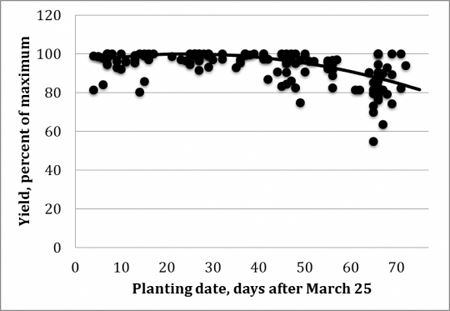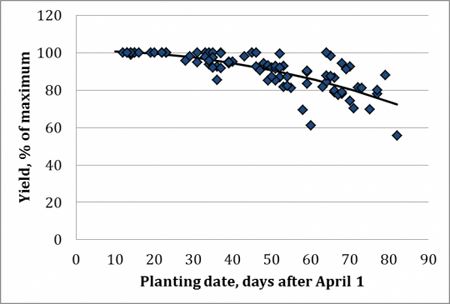|
Planting Date: Corn Or Soybean First?
DR. EMERSON NAFZIGER
URBANA, ILL.
Corn planting in Illinois has gotten into gear over the past week, with 12 percent of the state’s crop planted by April 17. That’s close to the planting pace of a year ago, and is behind the 5-year average only because that average includes 2012, when nearly half of the state’s corn crop was planted by mid-April. Illinois corn yield averaged 105 bushels per acre in 2012, while in 2014, the year with the record-high corn yield of 200 bushels, less than 5 percent of the Illinois corn crop was planted by this time in April. So while planting date is important, it is often overruled by what happens with the weather during the season.
We’ve run corn planting date studies at a number of locations over the past decade, with four planting dates at each site beginning in early April and going through late May or early June. We set the highest yield among the four planting dates at 100 percent, then express yields at the other three dates as a percentage of the highest yield. While percentage change is a good way to combine data over a number of sites, sites with low yields tend to inflate these percentages, and high yields mean lower percentages differences.
We have more data from central and northern Illinois than from southern Illinois, where wet conditions often rule out early planting. What we have from the southern third of the state shows a somewhat higher penalty with delays on a percentage basis, but because yields tend to be lower, not on a bushel basis. We often see oddities in the data, often the result of planting into soils that aren’t yet dry enough, form weed control issues, or from inconsistent rainfall on drought-prone soils.
Results from 35 trials in central and northern Illinois over the past nine years are summarized in Figure 1. According to this, percentage yield loss penalties with planting delays have not gone up in recent years, and may even be a little smaller than we observed previously. As predicted by the line fit to the points, the planting date producing the highest yield was April 17. But the response was very flat throughout April, within one percentage point (about 2 bushels) of the maximum between April 5 and April 25.
In four cases yields from early April planting were more than 10 percentage points below the maximum for that site. These yield losses from early planting may have been in part due to cooler temperatures after emergence that caused a physiological effect, but they also occurred in trials where the maximum yield was low, so may also have been related to below-average water supply during mid-season, with rainfall helping later plantings more than early ones. While lower yields from early April planting about one time in ten (4 trials out of 35) doesn’t represent a large potential for loss, it does reinforce the point that getting corn planted by mid-April isn’t likely to produce higher yields compared to planting in the second half of April.
From the line in Figure 1 we predict yield loss for April 30 of only 1 percentage point (2 bushels), and losses of about 4 percent (8 bushels), 8 percent (17 bushels), and 14 percent (29 bushels) with planting on May 10, May 20, and May 30, respectively. We don’t have a lot of data for June planting, but the yield loss going into June is at about 2 bushels per day of delay, and is accelerating.
Soybeans
We’ve been running soybean planting date studies over the past six years at the same sites as the corn planting date studies. Our earliest soybean plantings were generally in the second week of April; we did not try to plant as early in April as possible. Latest plantings were in early to mid-June.
As we found with corn, getting good data from such trials in southern Illinois is not easy; in some cases it was well into May before we could plant the first date, and loss of plantings due to wet soils and poor stands was not unusual. What data we have from southern Illinois shows that planting earlier is usually better, but it also makes clear that stand establishment is critical, and that planting conditions and rainfall after planting can often have more effect than planting date.
The soybean yield response to over 23 site-years in central and northern Illinois is shown in Figure 2. This looks much like the planting date response for corn, though we did not see any yield loss from the earliest planting like we saw with corn. This may be because we didn’t start to plant as early. I did, however, elect to leave out the 2012 data from Orr Center (Pike County), where under extremely dry conditions that were relieved by rain in August, later plantings yielded twice what the mid-April planting yielded. Leaving such data out makes the figure look better, but doing so suggests that we won’t see this happen again so don’t need the data to help predict this. We of course have no way to know if that’s true.
The prediction line in Figure 2 shows that the maximum yield was at the earliest planting, and that yield loss by the end of April was about 4 percentage points, or about 2.5 bushels; average maximum yield was 67 bushels per acre. Losses by May 10 were 7 percent (4 bushels); by May 20, 10 percent (7 bushels); by May 30, 16 percent (11 bushels); by June 10, 21 percent (14 bushels; and by June 20 yield loss totaled 29 percent and 19 bushels per acre. On a percentage basis these loss numbers are slightly greater than those from planting delays in corn, but some of this is due to the later first planting dates for soybean, and it’s safe to say that both crops lost yield at about the same rate as planting was delayed to late May.
Prioritizing planting: corn or soybean first?
Does the similarity in yield response to planting date mean that we should move soybeans ahead of, or at least equal to, corn in terms of planting priority once planting can begin? Probably not, at least when planting can begin by mid-April. That’s in part because corn seed emerges better under tough conditions than soybean seed, so there’s less (but not zero) chance of poor corn stands with early planting.
The most common cause of soybean stand loss is heavy rainfall after planting and before emergence. The chances of getting such rain don’t depend much on planting date, but the crop takes longer to come up if it’s planted early, and this increases the chances of getting rain before emergence. Corn is not immune from this problem, but damage to corn stands usually requires low temperature at the same time the soil is wet, so is somewhat less likely. In 2015 there were corn stand problems related to rain followed by cool temperatures in late April, which resulted in what we think was “imbibitional chilling injury” or physiological damage to the seed and seedlings caused by the intake of cold water.
A late frost would hurt both early-planted crops. We’ve had much less frost injury on soybean than on corn over the years, mostly because there aren’t many soybeans planted early enough to experience frost, but also because soybean plants are susceptible to being killed by frost for only a few days as they are emerging. Late frost is rare enough, though, that this isn’t a very important consideration.
Even if corn planting starts first, we should keep in mind that getting both crops planted as soon after mid-April as conditions permit will benefit both about equally. If the next corn field to be planted is on the wet side, in other words, it might pay to go to the (drier) soybean field to plant rather than to wait, though depending on the size and type of planter, switching between crops may not be quick or easy. Planting both crops at the same time with different planters might also be an option for some.
While getting both crops planted on time is beneficial, we shouldn’t lose sight of the fact that yield losses for delays into and even past mid-May are not so large that we need to give up hopes for a good crop if we aren’t done planting by the end of April. Statewide, the average date by which half the corn crop planted is about May 4, and for soybean it’s about May 23. These are later than we’d like mostly because soils are often wet, not because we can’t plant faster once fields are fit to plant. As much as we’d like to, it’s not clear how much we can move these dates earlier; we certainly can’t fix the weather, and we can’t (or shouldn’t) plant in mud. Regardless of planting date, we need to concentrate on making sound management decisions that allow the crop to take advantage of growing season conditions. ∆
DR. EMERSON NAFZIGER: Research Education Center Coordinator, Professor, University of Illinois

Figure 1. Corn planting date response over 35 Illinois site-years, 2007-2015. Yields are expressed as a percentage of the yield produced by the highest-yielding date at that site.

Figure 2. Soybean planting date response over 23 trials in central and northern Illinois, 2010-2015. Yields are expressed as a percentage of the yield of the highest-yielding date within each trial.
|
|